-
Cell division in vertebrates takes two forms
mitosis and meiosis
-
The standard form of cell division in somatic cells, and it results in two genetically equal daughter cells; one component of the cell cycle
mitosis
-
It is confined to certain stages of development of gametes
meiosis
-
Immediately after mitosis and the separation of the dividing cell into daughter cells, the G1 (gap 1) period called the ___
During the G1 period, the cell carries out its normal set of activities, such as specific synthesis, secretion, conduction, and contraction.
interphase
-
At the other extreme, the G1 phase of mature neurons persists as the G0 phase throughout the remainder of the life of the cell because further cell division does not occur
postmitotic cells
-
This occurs if a cell is in a dividing population; a preliminary to mitosis
DNA Synthesis
-
Period of DNA synthesis
S Phase
-
Phase that constitutes the period between the end of DNA synthesis and the beginning of mitosis itself
G2 Phase
-
It is under the control of proteins that are found essentially unchanged across the phylogenetic spectrum in organisms as diverse as mammals and yeas
cell division
-
A complex of two proteins, cdc 2 (cell division cycle 2) and cyclin, which lead the cell through its cell cycle
maturation-promoting factor (MPF)
-
Is present throughout the cell cycle, whereas cyclin undergoes its own cycle of synthesis and destruction
Cdc 2 (also called p34)
-
Synthesized during the G1 period and before mitosis it binds with cdc 2 to form a prematuration-promoting factor (pre-MPF) during the G2 period. With the shift of a phosphate group from cdc 2 to the attached cyclin molecule, the complex is converted to an active form of MPF, which stimulates mitosis to begin
Cyclin
-
MPF exerts many effects on the cell, including the initiation of breakdown of the nuclear envelope and stimulation of assembly of the mitotic spindle through ___ of proteins
phosphorylation
-
Proteins of the nuclear envelope that dissociate when phosphorylated, causing a disintegration of the nuclear envelope. Active MPF also activates enzymes that break down cyclin
nuclear lamins
-
After cyclin levels drop below a threshold, cdc 2 loses its activity, bringing mitosis to an end. Upon the loss of MPF activity, ____ remove phosphate groups that were added to proteins under the influence of MPF.
These inactivate the enzymes that breakdown cyclin, allowing it to accumulate in the cell during G1
cellular phosphatases
-
Process in the nuclear lamins that allows them to reassociate and reform the nuclear envelope in preparation for the initiation of the next mitotic cycle
dephosphorylation
-
Genes are active in the zygote where they are tightly complexed with basic proteins called
histones
-
The chromosomal DNA plus its enveloping histones
chromatin
-
Densely staining chromatin seen within the nucleus at both light and electron microscopic levels that represents inactive or repressed genetic material
heterochromatin
-
Morphologically associated with the disappearance of heterochromatin by removal of histones from active areas of the chromosomes
derepression
-
Active chromatin, which is not readily visible, is called
euchromatin
-
The first genes to become derepressed are those involved with the
proliferative and general metabolic activity of the cell
-
As cleavage progresses and the embryo enters the stage of gastrulation, the first _____ become activated.
tissue-specific genes
-
Later, during the period of organogenesis and histogenesis, other genes _________ come into play
controlling more specific activity of differentiated cells
-
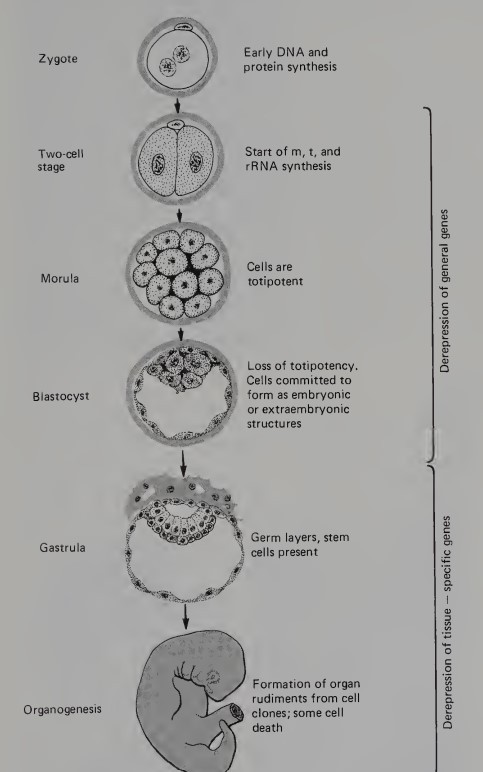
zygote -> two-cell stage -> morula -> blastocyst -> gastrula -> organogenesis
early mammalian development
-
Studies on _____ in insects have shown that at a given stage of development certain genes are activated, whereas at another stage the same genes are repressed and other genes are activated
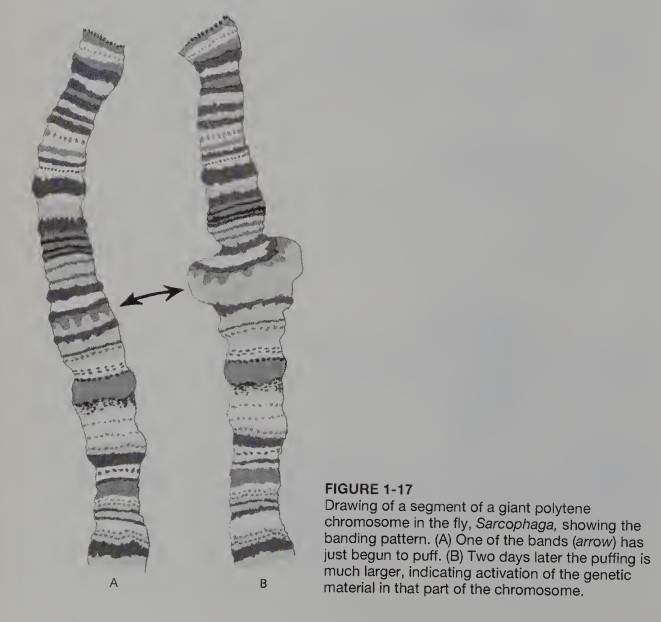
giant polytene chromosomes
-
With the widespread use of techniques such as ______, the embryological literature is becoming flooded with descriptions of the localization of expression of specific genes in developing systems
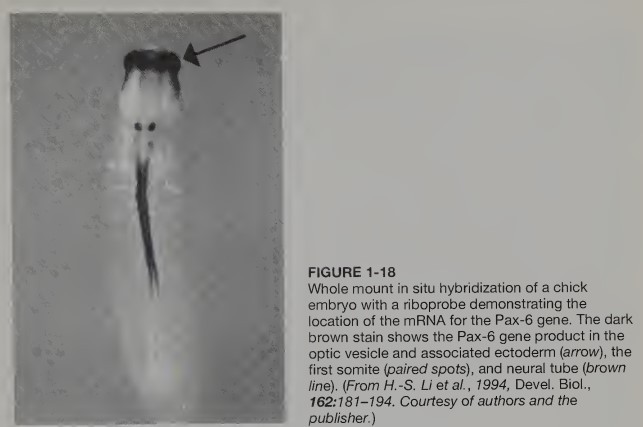
in situ hybridization and immunocytochemistry
-
This is where the capability to form an entire organism lies
Within the fertilized ovum
-
In many vertebrates the individual cells resulting from the first few divisions after fertilization retain this capability
totipotent
-
As development continues, the cells gradually lose the ability to form all the types of cells that are found in the adult body. It is as if they were funneled into progressively narrower channels. The reduction of the developmental options permitted to a cell is called
restriction
-
Shortly after fertilization the zygote undergoes a series of cell divisions called _____.
Early in this stage, the cells commonly remain totipotent
cleavage
-
The period of cleavage comes to an end when certain cells in the embryo undertake extensive migrations and rearrange themselves into three primary germ layers during a process known as
gastrulation
-
Named on the basis of their relative positions, the outermost germ layer
ectoderm
-
Innermost germ layer
endoderm
-
Between two germ layers
mesoderm
-
By this time (gastrulation) at least one stage of ______ has usually occurred, so that the cells of the three germ layers are now locked into separate developmental channels and are no longer freely interchangeable
restriction
-
In the next major developmental event, part of the ectoderm becomes thickened and is henceforth committed to forming the brain, the spinal cord, and other associated structures.
The remainder of the ectodermal cells can no longer form these structures and have thus undergone another phase of restriction. Soon, as a result of tissue interactions with the newly forming brain, groups of ectodermal cells become committed to forming the lens and inner ear, whereas the remainder of the ectoderm ultimately loses this capacity.
neurulation
-
Subsequent developmental events see the ectoderm further subdivided into groups of cells destined to form cornea; hair, scales, or feathers; cutaneous glands; or simply _____
epidermis
-
When restriction has proceeded to the point at which a group of cells becomes committed to a single developmental fate (e.g., the formation of cornea) has taken place in cells; represents the final step in the process of restriction
determination
-
Tissue interactions that shortly precede the process of determination (and some phases of restriction); one of the most important varieties of embryonic signal calling
inductions
-
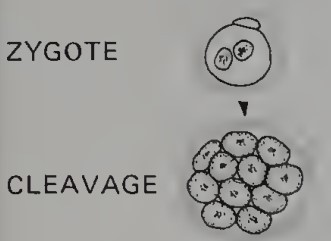
Developmental Event: Zygote -> Cleavage
Developmental Potential of Cells: Cells Totipotent
-
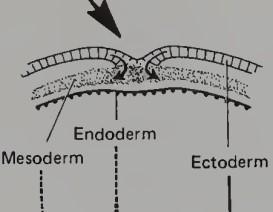
Developmental Event: Gastrulation
- Germ-layer formation (ectoderm, mesoderm, and endoderm)
Developmental Potential of Cells: Ectodermal derivatives:
- brain, spinal cord, peripheral nerves, pigment cells, inner ear, retina, iris, lens, cornea, skin glands, hair, scales, feathers, epidermis, adrenal medulla, etc.
-
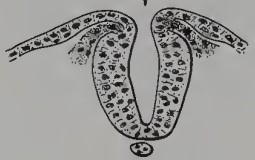
Developmental Event: Neurulation (Neural Induction)
- Central Nervous System
- Neural Crest and Derivatives
Developmental Potential of Cells: Remaining ectodermal potency:
- lens
- cornea
- skin glands
- hair, scales, feathers
- epidermis
-
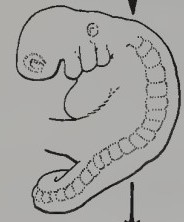
Developmental Event: Secondary Inductions
- Inner Ear
- Lens
Developmental Potential of Cells: Remaining ectodermal potency:
- cornea
- skin glands
- hair, scales, feathers
- epidermis
-

Developmental Event: Further Inductions
- Cornea
- Skin Glands
- Hair, Scales, Feathers
Developmental Potential of Cells: Remaining ectodermal potency:
- epidermis
-
Investigations on induction have involved (1) the discovery of inductive systems in embryonic development and (2) attempts to define the _________ of the inductive interaction
molecular nature
-
Classification of induction where an inductive signal is required to bring about the development of a specific structure (e.g., the metanephric kidney).
The responding tissue will form no other structure, even though artificial inductive stimuli are applied. In the absence of a this induction, the responding tissue fails to develop into any structure.
permissive induction
-
Classification of induction in which the responding tissue has the options of forming more than one type of tissue, depending upon the nature of the inductive stimulus.
For example, without the appropriate induction, cells that would have normally formed mesoderm in the early amphibian embryo go on to form ectoderm
instructive induction
-
The 1950s saw a new approach to the study of induction, when _____ (1956) showed that inductive events in the kidney could take place in vitro, with the inductor and responding tissues separated by a porous filter
Grobstein
-
Refers to the actual morpho¬ logical or functional expression of the portion of the genome that remains available to a particular cell or group of cells
differentiation
-
Differentiation is really the process by which a cell becomes specialized, and the final product is called
differentiated cell
-
The process by which individual tissues take on a characteristic appearance through differentiation of their component cells is called
histogenesis
-
The entire group of processes that mold the external and internal configuration of an embryo is included under the general term
morphogenesis
-
In many systems, __________ (laying down of the morphogenetic blueprint) is distinguished from morphogenesis (realization of the plans)
pattern formation
-
The concept of ______ (Wolpert, 1969) has clarified our understanding of some morphogenetic events.
A simplified explanation of this concept is that a given cell is able to (1) recognize its position in a coordinate system that is set up within the primordium of a structure and (2) differentiate according to its position
positional information
-
The developing embryo can be looked upon as a community of cells whose integrity and activities depend on a well-developed system of _____________
intracellular communication
-
Such intracellular communication takes place in localized _____________, where the membrane of one cell is in intimate contact with that of another
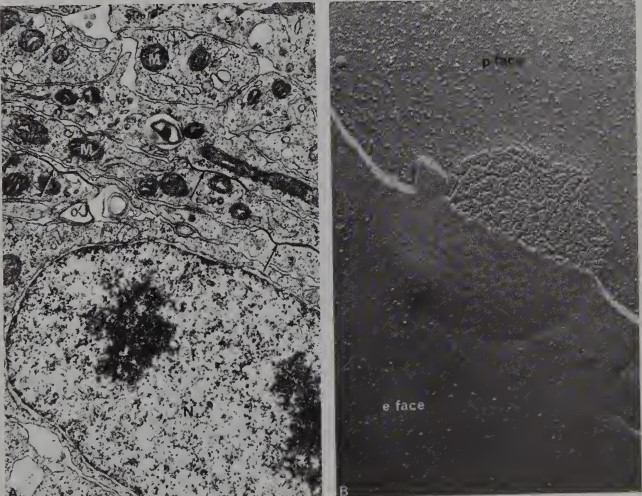
gap junctions
-
A unique form of individual cell movement occurs in early ____ embryos: The primordial germ cells move from the wall of the yolk sac into the bloodstream and are carried via the blood to the gonads
avian
-
Individual cells in embryos commonly migrate by means of ____________.
Although these cells are mesenchymal in appearance, they may originate from any of the three germ layers.
In this movement, the cell continually tests its surroundings and its activity is characterized by the presence of a ruffled membrane along the leading surface
ameboid movements
-
Cell death is a necessary component of many phases of development.
Although perhaps most spectacularly represented in some postembryonic events, such as the resorption of the tail, intestine, and opercular membrane of metamorphosing tadpoles and the liquefaction of most internal organs of a metamorphosing insect larva, cell death also occurs in many regions of avian and mammalian embryos
Apoptosis
-
It has become increasingly clear that many structures in the embryo arise from the descendants of small numbers of cells.
A group of cells arising from a single precursor is called a
clone
-
If part of a structure is lost by accident or through experimental manipulation, the loss is recognized, and reparative processes are set in motion. If this occurs before differentiation of the structure has set in, the restoration of the missing material is called____
The basis for the development of identical twins
regulation
-
In mammals, including human beings, twinning usually results from the subdivision of embryos during the early stages of cleavage.
Each half of the embryo is able to compensate for the lost tissues and develop into a perfectly normal individual.
Occasionally separation of the two portions of the embryo is incomplete. This results in the formation of _________
conjoined twins
-
Areas of the body that are able to reconstitute lost portions; A region of the body, such as that surrounding an appendage bud, in which the cells as a group are somehow cognizant of the overall nature of the structure to be formed
morphogenetic field
-
Sometimes in the late embryo or in postnatal life, a missing structure can be replaced. If the differentiation of recognizable structures has already occurred, the process of replacement is called _________
regeneration
-
One of the main features of a regenerating system is the formation of a mass of primitive-appearing cells called the __________ that demonstrate many of the properties of the embryonic primordium of the structure
regeneration blastema
-
Increase in mass; may involve a proportional increase in dimensions
growth
-
Growth involves a proportional increase in dimensions, but commonly all parts of the embryo do not grow at the same rate
differential growth
-
The body grows to a certain point that is characteristic of the species and sex, and then growth ceases. This is the common mode in mammals, whether the endpoint be a body the size of a shrew or a blue whale
determinate growth
-
More common in more ancestral vertebrates, such as fishes, in which growth continues throughout the life span, although at a reduced rate in later life. This characteristic makes it possible to determine the age of a fish by examining the annual growth rings on its scales or in cross sections of certain skeletal elements
indeterminate growth
-
The story of individual development sketches for us an approximate outline of the evolutionary changes passed through by our forebears.
biogenetic law of Muller and Haeckel
-
In essence the law tells us that an animal in its individual development passes through a series of constructive stages like those in the evolutionary development of the race to which it belongs. More technically and more succinctly, ontogeny is an abbreviated recapitulation of phylogeny
biogenetic law
-
Establishes the inherent potentialities of a developmental system or an individual.
heredity
-
Determines how far an individual can go toward a full realization of this inheritance
environment
-
1. Direct Observation of Living Embryos
2. Examination of Fixed Material
3. Histochemical Methods
4. Autoradiography
5. Tracing Methods
6. Immunological Methods
7. Microsurgical Techniques
8. Culture Techniques
9. Biochemical and Molecular Techniques
10. Irradiation Techniques
11. Inhibitory Agents and Teratogens
12. Developmental Genetics and the Use of Mutants and Genetic Markers
methods used in the study of embryonic development
-
Earliest technique used in embryology; provides one with a good overall view of the embryo and impresses the observer with the dynamic and often sweeping changes that constitute embryonic development
Direct Observation of Living Embryos
-
A powerful tool for investigating the development of entire embryos or groups of cells. This technique provides a moving picture of development, usually accelerated by a considerable extent, that can later be subjected to quantitative analysis.
Microcinematography
-
Application of _______ to cells or groups of cells allows these structures to be traced over a period of time.
Certain stains, such as Nile blue sulfate and neutral red, can be applied to living cells without harming them
vital dyes
-
The preservation of structures by treating the tissue with substances like formalin or glutaraldehyde that preserve structures without causing undue distortion or other artifacts in the tissue
fixation
-
With the ready availability of laboratory computers, serial sections can now be digitized and three-dimensional reconstructions made through techniques of
image analysis
-
Through this, it is possible to make optical sections through fluorescently stained tissues or entire early embryos (up to 100 p,m. thick)
confocal microscope
-
Another dimension in the study of embryos is added by the application of __________. This technique produces a three-dimensional view of the surfaces of entire embryos or parts of embryos with exceptional clarity and resolution
scanning electron microscopy
-
A method of localizing specific chemical substances or sites of chemical activity on morphological structures that are disturbed as little as possible
histochemistry
-
Typically, the tissue or embryo is rapidly frozen in liquid nitrogen and sectioned with a special low-temperature microtome called a
cryostat
-
A technique that allows the localization of a radioactive isotope within cells or tissues by employing methods similar to those used in photography.
Typically, a radioactively labeled amino acid or a precursor of DNA or RNA is administered to an embryo and shortly thereafter the embryo is fixed and sectioned for microscopic examination.
autoradiography
-
A technique that allows the localization of specific types of RNA molecules is
in situ hybridization
-
Another tracing method consists of injecting tiny amounts of __________ into cells. When a cell containing injected ___ divides, the enzyme is distributed in the daughter cells. It can be injected into one cell of an early embryo. The embryo is allowed to develop for a time, and then it is sectioned.
horseradish peroxidase (HRP)
-
Engineered to contain a reporter gene, e.g., beta-galactosidase, become incorporated into the DNA of the cellular host, and the reporter gene is expressed in that cell, where the gene product can be demonstrated with a histochemical reaction
retroviruses
-
If prepared properly against specific antigens, _________ can be valuable in studies of development because they can be used to probe for the specific presence or absence of the antigenic molecule in question in a tissue or organ.
antibodies
-
The name commonly given to the localization of specific molecules in tissues by means of antibodies is
immunocytochemistry
-
One of the simplest is ablation, or removal of part of an embryo to determine what effect the absence of that structure will have on the remainder of the embryo. Transplantation and explantation are commonly used surgical techniques that have found wide application in embryological studies
microsurgical techniques
-
A surgical technique that consists of excising a small sample of embryonic tissue and growing it in an artificial environment.
explantation
-
Some embryonic primordia show a striking capacity for ____________, indicating that within the transplanted cells there is sufficient information to direct the development of the organ
self-differentiation
-
The culture method was developed in a revolutionary experiment by _________, who was looking for a method to demonstrate the growth of nerves. In the time since his pioneer work, culture methods have contributed greatly to our understanding of developmental processes.
Ross G. Harrison (1907)
-
The first separation techniques were ___________. These techniques make use of the physical properties of compounds, such as amino acids or proteins, which give them different migratory properties in solutions or in electrical fields.
paper chromatography and electrophoresis
-
These different forms of molecules with the same enzymatic activity but with slightly different structures that enable them to be separated from one another.
Because different ______ forms of a given enzyme are often formed by separate populations of cell types at various times, they often make good developmental markers
isoenzymes (isozymes)
-
1. Paper chromatography and electrophoresis
2. Centrifugation of solutions or tissue homogenates containing macromolecules
3. Hybridization of DNA and DNA/RNA strand
separation techniques
-
This technique has proved to be very valuable in demonstrating the presence or absence of specific sequences of bases in the nucleic acids of embryonic cells
hybridization
-
A more recent technique that uses hybridization to amplify the amount of a specific nucleic acid sequence, for example, an mRNA message that may be present in very low abundance in an embryonic tissue
polymerase chain reaction (PCR)
-
The construction of synthetic genes; allows one to produce large quantities of a given DNA sequence; accomplished with the help of plasmids
recombinant DNA

